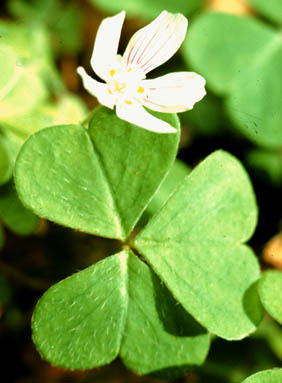Courtesy of Texas A&M University |
Courtesy of Texas A&M University |
Courtesy of Texas A&M University |
Oxalis montana
Author: Stephen M Sabourin
Ecology student, University of Georgia, 1999
Courtesy of Texas A&M University |
Courtesy of Texas A&M University |
Courtesy of Texas A&M University |
Common Names: (Gleason & Cronquist, 1991)
|
Photo courtesy of the Terra Foundation |
Higher Taxa: The genus name Oxalis is derived from the Greek word
"oxys", which means sour. The species name montana is of Latin origin and
means "of the mountains." The plants of this genus produce a significant
amount of oxalic acid in their leaves which gives them a sour taste.
Note: Some earlier authors included the species O. acetosella L. and O.
montana L. as separate species. However, they are treated in this
reference as the same species, where the only difference is whether the species is native
to Europe/Asia (O. acetosella) or North America (O. montana).
| Phylum: Phanerogamae Subphylum: Angiospermae Class: Dicotyledoneae Order: Geraniales Family: Oxalidaceae Genus: Oxalis Species: Montana (Porter, 1967) |
 Photo by: W. H. Duncan Photo courtesy of University of Georgia Herbarium |
Description: The species was first described by Linnaeus. When and where the holotype was discovered could not be found. The location of the holotype could not be found either. Radford, Ahles, and Bell (Radford et al., 1968) describe the species as follows, "acaulescent herb with scaly rhizome. Petioles and peduncles spreading pubescent. Leaflets 0.8-2 cm long (from notch to base). Chasmogamous flowers long-pedunculate, usually overtopping the leaves; sepals 3-4 mm long; petals white with a red or pink band near base or rarely all pink, 1-1.5 cm long. Cleistogamous flowers short-peunculate, shorter than the leaves; sepals 1.5-2 mm long. Capsule 3-4 mm long, 4-5 mm in diam., tapered to a point. Seeds smooth. (n=11) May-July (Chasmogamous), June-Sept. (cleistogamous). Rich, moist forest, often under hemlocks, spruce or fir at high elevations; mtns."
Manor house (Manor-House, 1999) describes the O. montana as "a low spreader that roots where its nodes touch the ground. Creeping stems emerge from a slender taproot. The clover-shaped leaves have a sour taste, are palmae, and are divided into 3 heart shaped leaflets, and are attached to the tip of a long petiole. They are usually smooth with hairs at the edge. The leaves and stems often have a slight purple color. Each leaflet is 1/2-3/4 inch wide." In the evening and in bad weather, the leaves fold in half at the midrib to conserve water and carbon dioxide loss.
Manor house (Manor-House, 1999) describes the flowers as "usually borne singly but sometimes appear in umbels. They are radially symmetrical, sepals numbering 5, and usually separate at the base." The fruit is described as "a seed capsule on a straight or ascending stalk. The seed capsules are hairy, cylindrical and 1/3 to 1 inch long, with 10-50 seeds in each. Mature seed pods open explosively, and can send seeds 10 feet."
Oxalis montana L. |
||
Area |
Status |
References |
| North America: Continental United States; Canada |
Yes |
|
| Northern hardwood and spruce-fir forests of Appalachian Mts. | Common |
|
| Eastern North America: United States east of Mississippi: Ontario and eastern Canada | Yes |
|
| Southeastern United States: AL AR DE DC FL GA KY MD NC SC TN VA WV | Yes |
|
| Southern Appalachian States: AL GA KY MD NC SC TN VA WV | Yes |
|
| Coastal Plain | No |
|
| Piedmont | No |
|
| Blue Ridge Mountains | Yes |
|
| Great Smoky Mountains National Park | Yes |
|
| Ridge and Valley | Probably Not |
Sabourin, 1999 |
| Georgia | Yes |
|
| Clarke County, Georgia | Probably Not |
Sabourin, 1999 |
| Europe | Yes |
Sabourin, 1999 |
| Asia | Yes |
Sabourin, 1999 |
Courtesy of Texas A&M
University Herbarium
Distribution map of O. montana in United States

Courtesy of The
University of Tennessee Herbarium
Distribution of O. montana in Tennessee

Natural History:
Habitat types and plant communities
Common woodsorrel is a dominant understory species in the northern hardwood forest, red or sugar maple, yellow birch, and American beech. It is also a dominant species in the transition plant associations between the boreal forest and the northern hardwoods. It is a minor component of the riparian communities in the northern hardwood forests. Frequent herbaceous codominants are false lily-of-the-valley, goldthread, starflower and woodferns. Associated understory species include lowbush blueberry, witherod, hobblebush and bunchberry (Pavek, 1992).
Common woodsorrel is a climax understory species. It is a tolerant species under mature fir canopy with low levels of light. Common woodsorrel is present in, although not characteristic of, early or mid- seral stages in New England’s northern hardwood or spruce-fir boreal forests. Disturbance occurs as severe winds, hurricanes, and fire (Pavek, 1992).
Common woodsorrel is found in soil with a pH which is strong to moderately acidic. A study conducted on O. montana in Finland (Viitaniemi Comprehensive School, 1998) found that the plant existed in soil with pH ranging from 4.3 in the less fertile areas up to a pH of 5.7 in the more lush areas. Saturated soils may be poor to moderately well drained. Soils are generally poorly developed and often consist only of an organic mat on top of bedrock. It is known as a soil stabilizer because it has extensive clonal growth and the ability to grow on steep ground, poor soil and in deep shade. It has been discovered from level to steep slopes. O. montana has been found to exist at 500 feet in Maine coastal forests to 5,000 feet in the Smoky Mountains of Tennessee and North Carolina (Pavek, 1992). O. montana is known to grow in full shade and direct sunlight but is more often found in a shadier environment.
The growing season throughout its range is from 110 to 140 days and is relatively cool with ample moisture in the soil. The average annual temperatures are less than 60 degrees Fahrenheit. Moss coverage can be low to high, and a high fern coverage will reduce O. montana populations (Pavek, 1992).
| Ecosystems Spruce – fir |
Cover types Jack pine |
Plant associations Northeastern spruce – fir
forest |

Common woodsorrel reproduces both sexually and asexually. Asexual flowers (cleistogamous)
produce greater amounts of seed compared to sexual flowers. Total fruit set per plant is
low because there is only one flower per stalk. Mature capsule dehisce seeds forcefully,
flinging them outward from the plant (Pavek, 1992).
Photo by: C. Mark Bowers
Courtesy of Botanical Society of Western
Pennsylvania
Life cycle and Population Dynamics
Reproduction usually involves episodes of seedling recruitment as a result of
disturbance, such as fire and logging, followed by long periods of vegetative clonal
growth. Common woodsorrel forms extensive colonies, however, its colonies rarely exceed
several feet in diameter (Pavek, 1992).
Most plant growth will occur before the flowers are out. In a population, the flowering period will last approximately 30 days, with individual flowers open for about five days. Fruit maturation takes about 12 days and requires warm days prior to dehiscence. The seeds are shed from June to September throughout its range (Pavek, 1992).
How to encounter
The common woodsorrel, O. montana, grows abundantly in shaded woods as a forest
understory. It is most commonly found in spruce-fir boreal forests in shady
patches. The asexual flowers can be encountered from June through September, whereas the
sexual flowers are abundant from May to July. O. montana is very abundant in the
Smokey Mountains along the Tennessee, North Carolina border in the lush growth forests. It
is most likely to be encountered at the higher altitudes. O. montana does tend to
form cohorts of a relatively good size so that you would not have to look hard for an
individual species when searching.
Cox, D. D. 1985. Common Flowering Plants of the Northeast. State University of New York Press. Albany, NY.
Fernald, M. L. 1950. Gray’s Manual of Botany. American Book Company. New York, NY.
Gleason, H. A., A. Cronquist. 1991. Manual of Vascular Plants of Northeastern United States and Adjacent Canada 2nd Edition. The New York Botanical Garden. Bronx, NY.
Pavek, D. S. Oxalis montana. 1992. The Fire Effects Information System [Data base]. Department of Agriculture, Forest Service, Intermountain Research Station, Intermountain Fire Sciences Laboratory.
Porter, C. L. 1967. Taxonomy of Flowering Plants. W. H. Freeman and Company. San Francisco, CA.
Radford, A. E., H.E. Ahles & C. R. Bell. 1968. Manual of the Vascular Flora of the Carolinas. University of North Carolina Press. Chapel Hill, NC.
University of Georgia Herbarium. University of Georgia. Copyright
1999.
Internet References
Manhart, James. 1999. Texas A&M University Herbarium. Texas A&M University. College Station, Texas.
Manor-House for Wiccan Studies. Copyright 1999.
Speedy, Scott. 1997. The Western Pennsylvania Botanical Society.
Terra Foundation Homepage. Copyright 1996.